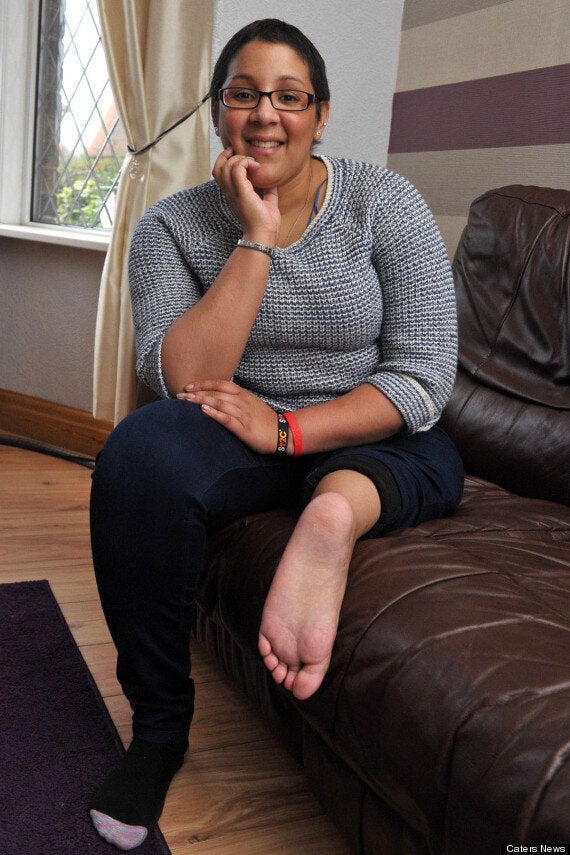After being diagnosed with bone cancer in her thigh for the second time, Jordon Moody was faced with a tough decision.
Her doctors told her that she would either have to lose her whole leg, or they could move the bottom half of her leg up to replace her thigh and attach her foot as a knee joint.
Obviously this isn't news that any 22-year-old wants to hear.
But opting for the lesser of two evils, Jordon agreed to rotationplasty - a surgical procedure which involves creating a new knee joint using her foot, which is then attached backwards.

Jordon was studying performing arts in New York when doctors first discovered she had cancer in her thigh.
She stayed in America for the next year, enduring chemotherapy and an operation to remove the tumour.
After being given the all-clear, Jordon returned to England to the home she shared with her parents Lieca and Ivory and two sisters Jem, 23, and 16-year-old Tanika.
But, during a visit to her godmother in Germany last year, she suffered excruciating pain and was rushed to hospital.
SEE ALSO:
Breast Cancer Awareness: How Air Conditioning Alerted This Woman To A Lump In Her Breast
Meet The Man Who Beat Cancer In His Teens And Became A Bodybuilder
Jordon flew back to England and was taken to St James’s Hospital in Leeds for more tests where doctors confirmed the cancer had returned and she was facing the amputation of her leg.
The 22-year-old said: “The pain was worse than ever and I just couldn’t move it.
“It was so scary, especially in light of the fact that the more times you get cancer, the less likely chemotherapy is going to work. In all honesty, you just have the fear that you are going to die. It’s there in the back of your mind all the time.”
Doctors then gave Jordon her options. She chose rotationplasty.
Jordon's surgery involved her thigh being amputated and her lower leg was moved up in the place of her thigh. Her foot has replaced where her knee would be, but rotated 180 degrees, leaving her toes twisted backwards and her heel at the front.
Story continues below...
Surgeons attached the foot in the place of her knee so that Jordon can wear a prosthetic without pain, and with movement.
“At first after the surgery, it was awkward-looking so it was a real shock. It took some getting used it but now, it seems totally normal to me," said Jordon.
The 22-year-old, who is from from Hull, underwent the surgery at the Royal Orthopaedic Hospital in Birmingham in July and is now adapting to life with her new limb.
She's currently waiting to be fitted with a new artificial lower limb, which will be attached to the joint created from her foot.
“It seemed like I would have a better quality of life as I could have a prosthesis fitted. I have been on crutches since I had the first operation so it’s been a couple of years now. I also use a wheelchair," said Jordon.
“Hopefully, before Christmas, I will be walking unaided again. I’ve always been independent and I hate to feel dependent when I’m in a wheelchair or having to use the walking aids."
She added: “I don't go out much at the moment but I will be able to walk unaided if I get a prosthesis so that’s my aim now. That’s my goal.”
Lee Jeys, orthopedic oncology surgeon at the Royal Orthopedic Hospital, carried out Jordon's procedure.
He said: "Jordon had already had treatment in America for a thigh tumour and unfortunately we needed to remove the whole of her thigh bone.
"Instead of leaving Jordon without a leg, we connected her shin bone to the remaining thigh bone, creating a knee joint from her foot. The idea of the operation is where we turn the foot around and move it up, so Jordon could have a below the knee prosthesis.
"Otherwise she would have had to have an amputation and would have been left with no leg at all."
He added that the surgery is a technical one, and he only performs it about three times a year - usually on young patients. The aim of rotationplasty is so that patients can walk and will look completely normal in clothes.
He added: "Of course, out of clothes it looks a little unusual but we do it to offer patients the best functionality they can. Most patients will eventually be able to walk unaided."
